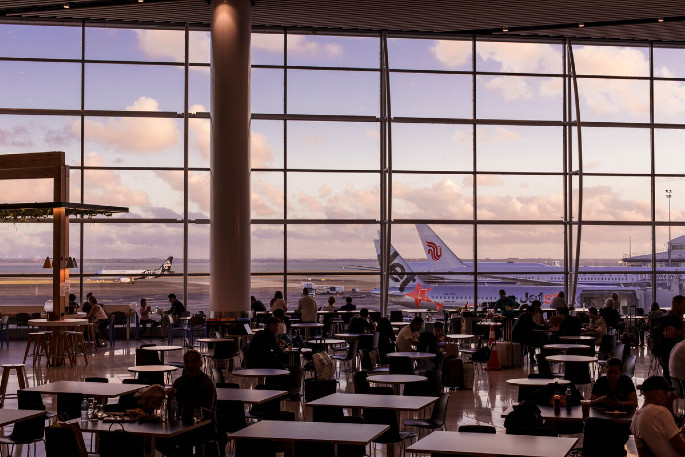Natural gas is on the way out at the country’s largest airport as Auckland Airport begins to switch its air conditioning system to electricity.
Auckland Airport chief sustainability and master planning officer Mary-Liz Tuck says gas used to heat the 141,000m2 international terminal is the leading contributor to Auckland Airport’s Scope 1 carbon emissions – emissions from operations the Auckland Airport owns and controls.
“Natural gas is one of the biggest contributors to carbon emissions across our operations, which is why our goal to completely replace gas is so important. This electric powered upgrade will go a long way to cutting the airport’s carbon emissions,” says Mary.
“We have made it a priority to cut fossil fuels from our day-to-day activities as much and as quickly as we can, which is reflected in a goal to be at net-zero direct carbon emissions by 2030. We’re targeting a 90 per cent reduction in scope 1 and 2 emissions and nearly half that will come from eliminating the use of natural gas in the international terminal by the end of the decade.”
The fully electric HVAC replacement will be rolled out to coincide with construction at the international terminal including a planned upgrade to Pier A, the main departure and arrival point for international aircraft, and the new domestic terminal integrated into the international terminal.
“Building efficient, fit for purpose infrastructure enables us to fast-track emissions reductions. With both these projects due to be completed before the end of the decade, it makes sense to time the upgrades with that major work.”
While gas used by food and beverage outlets will be tackled in the coming years, the first, and biggest, saving will come from replacing six natural gas boilers, totalling 6.5 megawatts of heating, with electric air-source heat pumps. Included in the switch is the introduction of innovative heat pump technology that warms and cools air simultaneously within the same unit – one of the first large scale units of its type in New Zealand.
“We’re all pretty familiar with air conditioning or heat pumps you switch to cool in summer and heat for the winter months,” says Mary.
“But we are currently testing leading edge technology that can cool one area within the terminal but take the heat that’s been extracted in the chilling process and pump it into a space that needs warming up. A traditional HVAC system would just vent that air as waste, so it’s doubling the efficiency and giving you a lot of bang for energy buck.
“At Auckland Airport we move a lot of air – up to 12 air changes an hour in some of our big dwell spaces. That currently requires about 15 megawatts of cooling. To give you a sense of scale that’s roughly 3000 of the air conditioning units you’d have at home.”
A unique challenge in managing air temperatures within an airport terminal are the passenger ebbs and flows, which can see spaces like departure gates or arrival processing areas go from virtually empty to filled with hundreds of people then back to empty again within a short space of time.
“Unlike say a shopping mall, which has a fairly steady stream of people across the day in its public areas, many of the spaces in the terminal can be very dynamic in terms of foot traffic.
“It’s not necessarily something you’d notice as a traveller because you’re moving through the airport with people on the same flight but boarding and disembarking 300 to 400 seat aircraft in a short space of time can fill and empty processing areas quite quickly.
“While it creates complexity when you’re trying to keep different spaces at a comfortable temperature throughout the day and night, we can see some real opportunities to harness the warmth of one area to take the chill off another, or vice versa.”
The first step is testing one 500kw unit featuring the new technology – roughly 100 times the size of a residential heat pump – on a couple of areas within the terminal.
“Over a 12-month period we’ll use it for air conditioning the Customs processing area and Pier B to really put it through its paces for not only the Auckland climate but those very ‘peaky’ heating and cooling needs across the day. There are very few sites in Australasia using this system at scale, so the team need to ensure it is fully road tested and fine-tuned for our specific airport needs before we begin investing in another 20 units, including heat pumps that solely heat or cool, to fully replace our gas-fired heating. We need to get this right.”
Using the latest air conditioning technology also provides an opportunity to use refrigerants with a low global warming potential and ozone depleting potential.
Currently there are no safe zero-emission refrigerants, and it is not known when it will be an option, so while Auckland Airport will keep an eye on developments to reach its sustainability targets it’s likely these emissions will be offset through the purchase of certified carbon removals.
“Our net-zero target is one Auckland Airport takes seriously and we will seek to use zero-emission solutions as we invest in our infrastructure. The Mānawa Bay premium outlet mall currently under construction will have what’s expected to be New Zealand’s largest rooftop solar system which will generate the equivalent of 80 per cent of the 100-store centre’s power usage when it opens in 2024. Our new Transport Hub will also feature solar generation, charging for EVs and an adjacent office building built to target a 5-Star Green rating,” says Mary.



